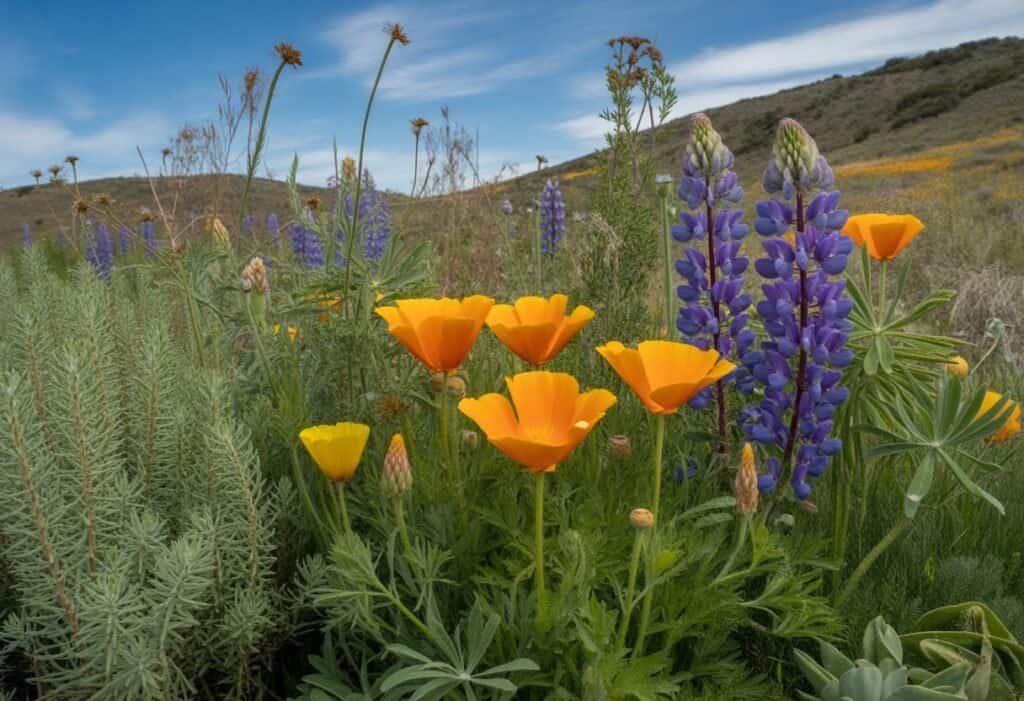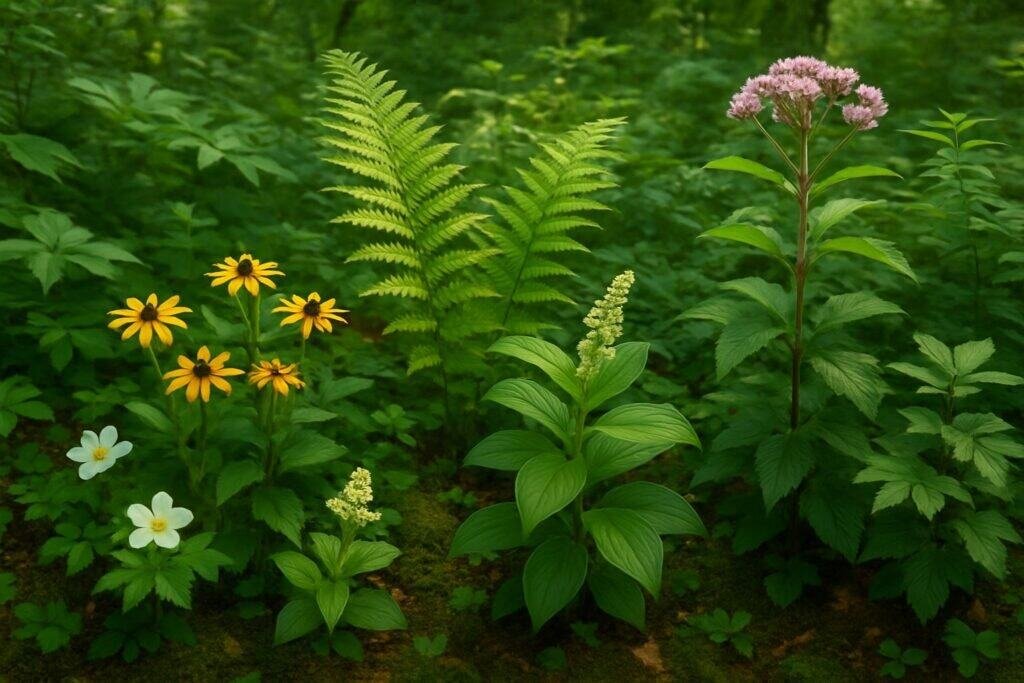Sacramento native plants offer incredible benefits for local gardeners. These plants have adapted to our unique climate over thousands of years.
They thrive with minimal water and maintenance while supporting local wildlife. Growing native plants in Sacramento gardens helps conserve water, reduce maintenance costs, and create habitat for local birds, bees, and butterflies.
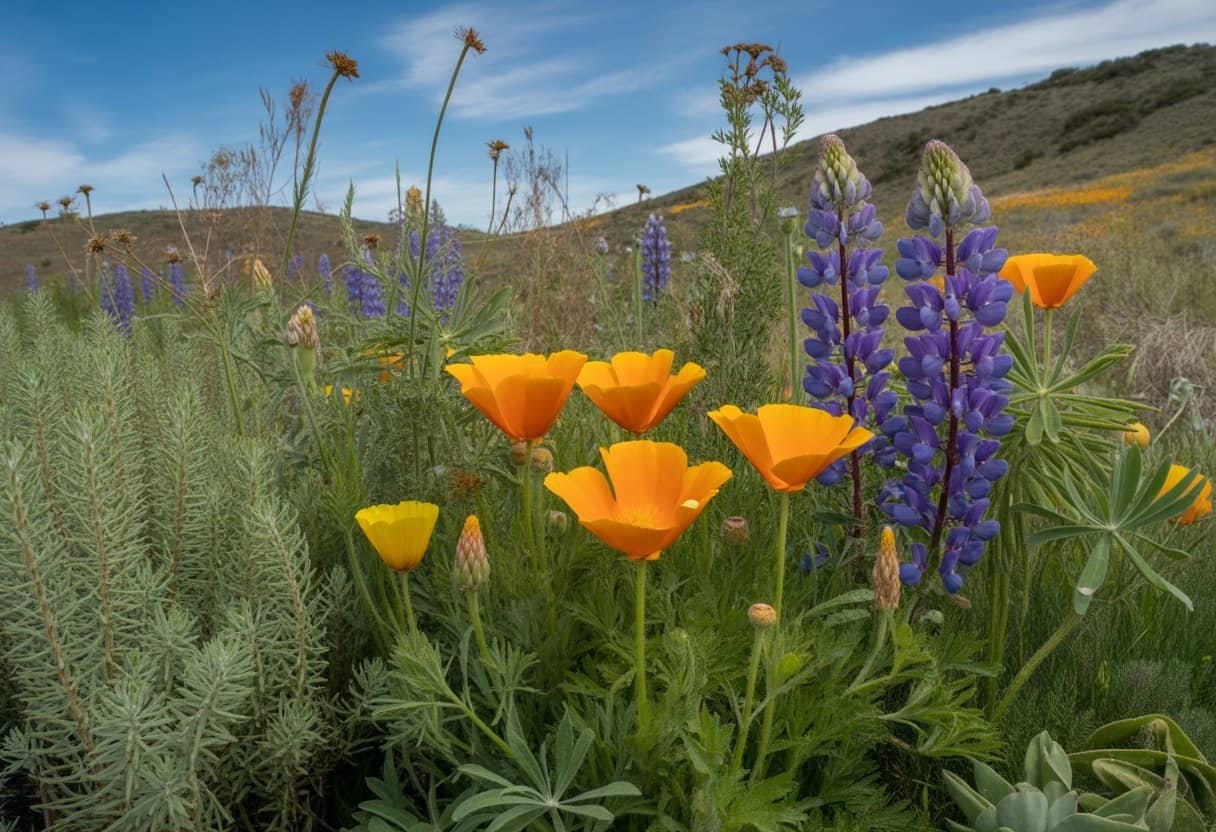
Our region boasts a diverse array of beautiful native options. From the vibrant orange of California poppies to the delicate blue blooms of ceanothus shrubs, Sacramento natives provide year-round interest.
They come in all shapes and sizes, from ground covers to majestic oaks. Native plants connect us to Sacramento’s natural heritage.
By incorporating these plants into our landscapes, we participate in ecological restoration. We also create sustainable, beautiful outdoor spaces that reflect our region’s unique character.
Key Takeaways
- Sacramento native plants require less water and maintenance while supporting local wildlife like birds and pollinators.
- Native plants come in diverse forms including colorful wildflowers, shrubs, and trees that thrive in our local climate.
- Local nurseries, plant sales, and demonstration gardens offer resources for finding and successfully growing native plants.
Understanding Sacramento Native Plants
Native plants in Sacramento evolved over thousands of years to thrive in our unique climate and soil conditions. These plants form the backbone of local ecosystems and offer many advantages for gardeners and the environment.
What Defines a Native Plant
Native plants are species that existed in the Sacramento region before European settlement. These plants evolved alongside local wildlife, creating interdependent relationships.
Sacramento’s native flora includes valley oaks, California poppies, and manzanita shrubs. These plants have adapted to the valley’s hot, dry summers and mild, wet winters.
They typically require little water once established, developing deep root systems to access groundwater. Native plants also have natural defenses against local pests and diseases.
This adaptation means they rarely need pesticides or special treatments to thrive. The Sacramento Valley’s unique soil composition—often clay-heavy with varying drainage—has shaped which plants naturally succeed here.
Native plants have adapted to these specific soil conditions over centuries.
Benefits for the Sacramento Valley
Sacramento native plants use 85% less water than non-native alternatives. This is a crucial advantage during California’s frequent droughts.
Native plants provide essential habitat for local wildlife. Birds, butterflies, and beneficial insects depend on these plants for food and shelter.
For example, milkweed species support monarch butterflies. Elderberry bushes host the valley elderberry longhorn beetle.
Using native plants helps preserve Sacramento’s natural heritage. As development transforms the landscape, home gardens with native plants create corridors for wildlife movement.
Native gardens need less maintenance than conventional landscapes. They need minimal fertilizer, reduce yard waste, and often stay healthier without intervention.
Selecting the Best Native Plants for Sacramento Gardens
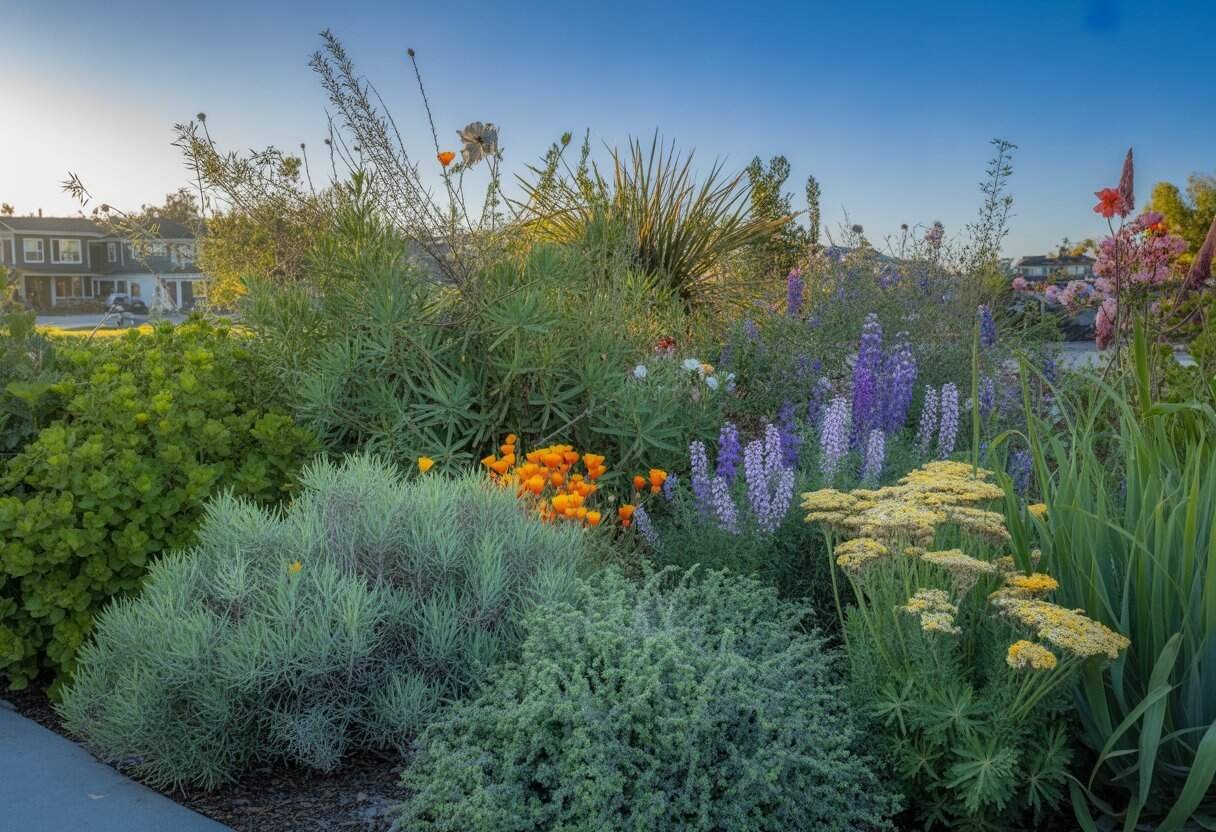
Choosing the right native plants for Sacramento gardens helps create sustainable landscapes that thrive in our local climate. Native plants require less water, support local wildlife, and showcase the natural beauty of California’s diverse ecosystems.
Popular Sacramento Native Plants Varieties
California Poppy (Eschscholzia californica) thrives in Sacramento’s climate with its bright orange blooms from spring through summer. This drought-tolerant state flower requires minimal care once established.
Manzanita (Arctostaphylos) varieties like ‘Howard McMinn’ offer year-round interest with red bark, pink flowers, and evergreen foliage. These plants handle our hot summers and need almost no water once established.
Ceanothus (California Lilac) brings stunning blue flowers in spring and attracts beneficial pollinators. ‘Concha’ and ‘Ray Hartman’ varieties work well in Sacramento gardens.
Western Redbud (Cercis occidentalis) delivers dramatic pink-purple flowers in early spring before its heart-shaped leaves emerge. This small tree adds multi-season interest and supports local wildlife.
Flowering Natives and Their Seasons
Spring Bloomers:
- Cleveland Sage (Salvia clevelandii) – Aromatic purple flowers
- California Buckeye (Aesculus californica) – Showy white flower spikes
- Blue-eyed Grass (Sisyrinchium bellum) – Delicate star-shaped purple flowers
Summer to Fall Performers:
- California Fuchsia (Epilobium canum) – Brilliant red-orange tubular flowers that hummingbirds love
- Goldenrod (Solidago californica) – Yellow flower plumes that support butterflies
- Gumplant (Grindelia) – Bright yellow daisy-like flowers with sticky buds
Many of these flowering natives create a succession of blooms, providing year-round interest and continuous support for pollinators. Most require full sun to light shade and minimal summer irrigation.
Native Shrubs and Groundcovers
Coffeeberry (Frangula californica) makes an excellent hedge or screen with its glossy evergreen leaves and berries that change from green to red to black. Birds enjoy the berries and the dense growth provides shelter.
Coyote Brush (Baccharis pilularis) serves as a versatile, drought-tolerant shrub that works well for slopes and erosion control. The compact ‘Pigeon Point’ variety makes an excellent groundcover.
Creeping Sage (Salvia sonomensis) spreads to form a beautiful groundcover with lavender-blue flower spikes in spring. Its aromatic gray-green foliage deters deer and requires almost no summer water.
Oregon Grape (Berberis aquifolium) offers year-round interest with holly-like leaves, yellow flowers, and blue berries. This shade-tolerant shrub adds diversity to woodland garden areas.
Garden Design Principles Using Native Plants
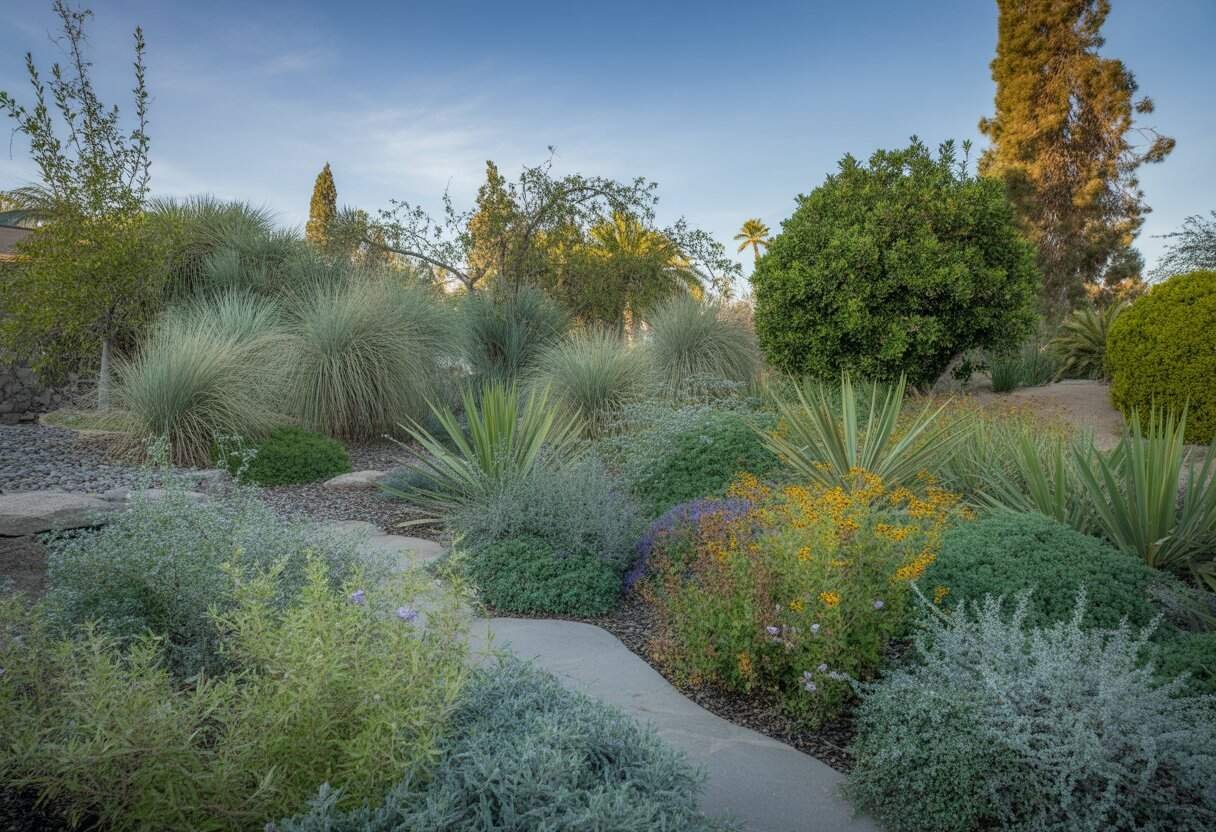
Sacramento native plants offer beauty, sustainability, and regional character when thoughtfully incorporated into garden designs. These plants naturally support local wildlife while creating distinctive outdoor spaces that thrive in our unique climate.
Creating Wildlife Habitat
Native plant gardens provide essential habitat for local wildlife. Birds, butterflies, and beneficial insects depend on these plants for food and shelter.
Choose plants that offer multiple habitat benefits. Toyon and Coffeeberry provide berries for birds and serve as nesting sites.
Manzanita offers protective cover and nectar-rich flowers. Create habitat layers in your garden:
- Canopy – Valley Oak, Blue Oak
- Understory – Redbud, Ceanothus
- Ground cover – Creeping Sage, California Fuchsia
Include water features like small ponds or bird baths. Even a shallow dish attracts beneficial insects and birds.
Leave some areas less manicured. Fallen leaves and plant debris create microhabitats for beneficial insects that help control garden pests naturally.
Maximizing Pollinator Support
Sacramento native plants evolved alongside local pollinators, making them ideal for pollinator gardens. Different pollinators need different types of flowers.
Plant for succession to ensure blooms throughout the growing season:
- Spring: California Poppy, Lupine
- Summer: Milkweed, Buckwheat
- Fall: Goldenrod, Aster
Consider flower shapes when selecting plants. Tubular flowers like Penstemon attract hummingbirds, while flat-topped flowers like Yarrow are perfect for butterflies.
Avoid pesticides in pollinator gardens. Even organic options can harm beneficial insects.
Group similar plants together in patches at least 3 feet in diameter. This makes it easier for pollinators to find and efficiently gather nectar and pollen.
Include host plants like Milkweed for Monarch butterflies. These plants support the complete lifecycle of specific pollinators.
Incorporating Native Plants into Public Spaces
Native plant landscaping in public areas creates community connection to local ecosystems. Parks, schools, and business complexes benefit from sustainable native plantings.
Consider visibility and safety when designing public native gardens. Choose lower-growing plants near walkways.
Place taller species toward the back of beds. Maintain clear sightlines in urban settings.
Educational signage helps visitors understand the ecological benefits of native plants. Simple plant identification markers with brief information encourage engagement.
Involve community members in planning and maintenance. Community participation builds investment in public spaces and spreads knowledge about native plants.
Design for accessibility so everyone can enjoy the space. Wide, firm pathways allow wheelchair access, while varying plant heights create interest for visitors of all ages.
Use native plants in rain gardens and bioswales to manage stormwater naturally. These functional landscape features can be both beautiful and educational.
Planting and Establishment Techniques
Successfully growing Sacramento native plants requires proper timing and preparation. The right approach to planting and early care increases survival rates and promotes healthy growth with minimal maintenance.
Timing and Site Preparation
Fall planting (October through December) gives Sacramento native plants the best chance to establish strong root systems. Winter rains provide natural irrigation while temperatures remain mild enough for root development.
Before planting, remove existing weeds completely, including their roots. This reduces competition for water and nutrients.
For areas with compacted soil, loosen the top 6-8 inches without disrupting the soil structure. Mark planting locations based on mature plant sizes.
Most Sacramento natives need space to grow naturally without frequent pruning. Small shrubs typically need 3-4 feet between plants, while larger shrubs need 6-8 feet.
Dig holes twice as wide as the root ball but only as deep as the plant’s container. This encourages roots to spread outward into surrounding soil.
Soil, Mulch, and Watering Advice
Most Sacramento native plants prefer well-draining soil similar to their natural habitats. Avoid amending soil extensively, as natives adapt to local conditions.
For heavy clay soils, adding 10-20% compost can improve drainage.
Mulching is essential for native plant success:
- Apply 2-3 inches of natural mulch around plants
- Keep mulch 2-3 inches away from stems and trunks
- Use wood chips, leaves, or pine needles rather than bark
Water deeply but infrequently after planting. New natives typically need water every 5-7 days for the first summer, then much less afterward.
Soaking the root zone thoroughly encourages deep roots instead of surface roots. Monitor soil moisture by digging 2-3 inches below the surface.
If soil feels dry at this depth, it’s time to water again.
Ongoing Maintenance and Care
Native Sacramento plants require less maintenance than non-native species, but they still need regular attention to thrive. Proper maintenance keeps your native garden healthy and beautiful throughout the changing seasons.
Pruning and Seasonal Tasks
Prune Sacramento native plants in late winter or early fall for best results. Remove dead or diseased branches first, cutting at a 45-degree angle just above a leaf node.
Many natives, like California lilac and manzanita, need minimal pruning—just enough to maintain their natural shape. In spring, add a thin layer of mulch (2-3 inches) to retain moisture and suppress weeds.
Use wood chips or leaf litter that matches the plant’s natural habitat. Fall maintenance includes collecting seeds from mature plants for future propagation.
Store seeds in paper envelopes in a cool, dry place. Winter is ideal for planting new natives.
The rainy season helps establish strong root systems before summer drought.
Seasonal Checklist:
- Spring: Light pruning, mulching
- Summer: Minimal watering for established plants
- Fall: Seed collection, planting preparation
- Winter: New plantings, major pruning
Managing Pests and Diseases
Sacramento native plants usually resist local pests and diseases better than non-natives. Prevention works best.
Maintain proper spacing between plants to ensure good air circulation. This reduces fungal issues common in Sacramento’s occasional humid conditions.
Monitor plants regularly for signs of trouble. Watch for yellow leaves, unusual spots, or insect damage.
Act quickly if you notice problems. You can handle most minor pest issues with a strong spray of water or insecticidal soap.
Beneficial insects are your allies. Attract ladybugs, lacewings, and predatory wasps by planting flowering natives like yarrow and buckwheat.
For stubborn pest problems, contact the UC Davis Master Gardener Program or the Sacramento Valley California Native Plant Society. These local resources offer region-specific advice for managing pests while protecting beneficial insects.
Finding and Purchasing Sacramento Native Plants
Sacramento offers many options for gardeners who want to buy native plants. Specialized nurseries and seasonal events provide everything from valley oaks to California poppies.
Local Native Plant Nurseries
Several nurseries in the Sacramento region specialize in California native plants. Elderberry Farms Native Plant Nursery in Rancho Cordova focuses on plants native to the Sacramento Valley.
They offer a wide selection of shrubs, trees, and perennials adapted to local conditions. California Native Plant Society’s Sacramento Valley Chapter maintains a demonstration garden and small nursery with plants propagated by volunteers.
Their knowledgeable staff can help you select species suited to your specific garden conditions. Green Acres Nursery has multiple locations around Sacramento and maintains a dedicated native plant section with seasonal availability.
Cornflower Farms in Elk Grove specializes in native plants for restoration projects but also serves home gardeners. Their inventory includes hard-to-find native grasses and riparian plants.
Annual Plant Sales and Events
The Sacramento Valley CNPS Chapter Plant Sale happens twice yearly, in spring and fall. These events, usually in April and October, feature hundreds of native plant species.
The UC Davis Arboretum Plant Sales include many California natives, especially those well-suited to Sacramento’s climate. These popular events often have lines before opening.
Sacramento’s Harvest Day at the Fair Oaks Horticulture Center includes a native plant section with demonstrations and sometimes plants for purchase. Several community gardens host seasonal exchanges where you can find native plants.
The Oak Park Seed Exchange increasingly features California native seeds and seedlings. Look for Master Gardener events throughout the year, which often include native plant sales and expert advice about growing natives in Sacramento gardens.
Community Resources and Educational Opportunities
Sacramento offers many resources for residents interested in learning about and growing native plants. Local organizations, gardens, and digital tools provide practical knowledge and hands-on experience for gardeners of all skill levels.
Demonstration Gardens and Tours
Several demonstration gardens throughout Sacramento showcase the beauty and variety of native plants. The Sacramento County Master Gardeners maintain a native plant garden at the Fair Oaks Horticulture Center, open for free public tours monthly.
The California Native Plant Society’s Sacramento Valley Chapter hosts seasonal garden tours. Visitors can explore private gardens featuring diverse native landscapes.
These tours usually occur in spring and fall when native plants are at their peak. Effie Yeaw Nature Center in Carmichael features interpretive trails with labeled native plants in their natural habitats.
Their guided walks provide insights into plant identification and ecological benefits. UC Davis Arboretum also maintains extensive native plant collections and offers regular docent-led tours focused on drought-tolerant landscaping.
Advocacy and Education Programs
The Sacramento Valley Chapter of the California Native Plant Society offers monthly meetings with expert speakers on topics such as plant identification and garden design. These gatherings are free and open to the public.
The Sacramento Master Gardeners program provides trained volunteers who offer free advice through their hotline. They also hold regular workshops on native plant gardening.
Their “Grow Native” series covers soil preparation, plant selection, and maintenance. Local nurseries like Elderberry Farms Native Plant Nursery host regular workshops on propagation techniques and sustainable gardening.
These hands-on sessions are especially helpful for beginners. Sacramento’s Water-Wise program offers rebates and educational resources for homeowners replacing lawns with native plant gardens.
Their website features detailed conversion guides and watering schedules.
Online Tools and Calscape
Calscape (calscape.org) is a user-friendly online resource from the California Native Plant Society. This database helps gardeners identify plants native to Sacramento’s climate zones.
You can search Calscape by zip code to find plants naturally occurring in your neighborhood. The site provides detailed growing information and nursery availability.
It also offers pre-designed garden plans suitable for Sacramento’s hot summers. The Sacramento Tree Foundation’s website provides native tree selection tools and planting guides specific to local conditions.
Their interactive maps show appropriate species for different city neighborhoods. Social media groups like “Sacramento Native Plant Gardeners” on Facebook offer community support, plant exchanges, and real-time advice from local gardeners.
Frequently Asked Questions
Sacramento gardeners often have questions about native plants for their yards. These FAQs address common topics about plant selection, purchase locations, and supporting local wildlife.
What are the top recommended native plants for landscaping in the Sacramento area?
California fuchsia, Cleveland sage, and manzanita are top native plants for Sacramento landscapes. These plants thrive in hot, dry summers and mild winters.
California poppies add vibrant orange color and reseed easily. Ceanothus (California lilac) offers spectacular blue blooms and attracts pollinators.
Deer grass provides year-round structure and movement in the garden. Toyon produces red berries that attract birds during winter.
These natives need minimal water once established and support local wildlife.
Where can I purchase native plants in Sacramento for my garden?
The Sacramento Valley Chapter of the California Native Plant Society holds seasonal plant sales with excellent selection. These events usually take place in spring and fall when planting conditions are ideal.
Elderberry Farms Native Plant Nursery offers regular retail hours and specializes in local native species. They provide plants propagated from Sacramento Valley genetic stock.
Several local garden centers now dedicate sections to California natives, including Green Acres Nursery & Supply and Talini’s Nursery.
Can you suggest a reputable native plant nursery in the Sacramento region?
Elderberry Farms Native Plant Nursery stands out as Sacramento’s premier native plant specialist. Located in Rancho Cordova, this nursery is operated by volunteers from the California Native Plant Society.
Cornflower Farms in Elk Grove focuses on natives for restoration projects but also serves home gardeners. They grow over 300 species of California native plants, trees, and shrubs.
Far West Nursery in Davis offers a good selection of natives and expert advice on plant selection and care.
How can I find drought-tolerant native plants suitable for Sacramento’s climate?
The Sunset Western Garden Book lists plants by climate zones, with Sacramento in zones 8-9. Look for plants marked as suitable for these zones with low water requirements.
The UC Davis Arboretum’s “All-Stars” program highlights tested, reliable plants for the region. Many California natives make this list due to their drought tolerance.
Local demonstration gardens display drought-tolerant natives in real landscapes. Visit the Water-Efficient Landscape Gardens at the Sacramento Water Conservation Demonstration Garden for ideas.
Which low maintenance northern California native plants thrive best in residential landscapes?
Ceanothus varieties offer beautiful blue flowers with minimal care. Once established, they rarely need extra water or fertilizer.
Manzanitas provide year-round interest with red bark, evergreen leaves, and winter flowers. They thrive in poor soils and need no summer irrigation.
Salvia spathacea (hummingbird sage) grows well in shade, spreads to form groundcover, and attracts hummingbirds. California buckwheat (Eriogonum) varieties offer long-lasting blooms and feed many beneficial insects.
What plant varieties are known to attract and support native bee populations in California?
Phacelia tanacetifolia (lacy phacelia) attracts many native bee species with its lavender blooms. This annual reseeds easily in the garden.
Solidago californica (California goldenrod) offers late-season nectar for bees and butterflies. Goldenrod does not cause allergies.
Erigeron glaucus (seaside daisy) blooms for months and supports specialist bee species. Native milkweed varieties host monarch butterflies and provide nectar for many bee species.

